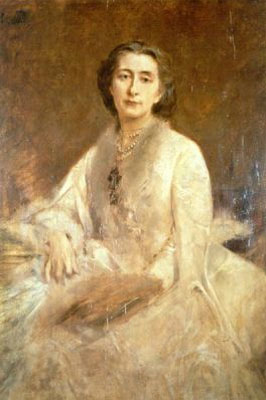|
Wahnfried
Wahnfried was the name given by Richard Wagner to his villa in Bayreuth. The name is a German compound of (delusion, madness) and (peace, freedom). Financed by King Ludwig II of Bavaria, the house was constructed from 1872 to 1874 under Bayreuth Carl Wölfel's supervision after plans from Berlin architect Wilhelm Neumann, the plans being altered according to some ideas of Wagner. He and his family moved in on 28 April 1874, while the house was still under construction. Engraved across the portal is Wagner's motto: ("Here where my delusions have found peace, let this place be named Wahnfried"), which initially caused some amusement among local townsfolk. Wagner did not spend the closing days of his life at Wahnfried, leaving Bayreuth on 6 September 1882 for the sixth and final time for Venice, where he resided until his death 13 February 1883 at the Palazzo Vendramin-Calergi. Wagner's body was repatriated to Wahnfried in a public procession through Bayreuth on 18 February, and ... [...More Info...] [...Related Items...] OR: [Wikipedia] [Google] [Baidu] |
Cosima Wagner
Francesca Gaetana Cosima Wagner ( née Liszt; 24 December 1837 – 1 April 1930) was the daughter of the Hungarian composer and pianist Franz Liszt and Franco-German romantic author Marie d'Agoult. She became the second wife of the German composer Richard Wagner, and with him founded the Bayreuth Festival as a showcase for his stage works; after his death she devoted the rest of her life to the promotion of his music and philosophy. Commentators have recognised Cosima as the principal inspiration for Wagner's later works, particularly ''Parsifal''. In 1857, after a childhood largely spent under the care of her grandmother and with governesses, Cosima married the conductor Hans von Bülow. Although the marriage produced two children, it was largely a loveless union, and in 1863 Cosima began a relationship with Wagner, who was 24 years her senior. They married in 1870; after Wagner's death in 1883 she directed the Bayreuth Festival for more than 20 years, increasing its reper ... [...More Info...] [...Related Items...] OR: [Wikipedia] [Google] [Baidu] |
:en:Cosima Wagner
Francesca Gaetana Cosima Wagner (née Liszt; 24 December 1837 – 1 April 1930) was the daughter of the Hungarian composer and pianist Franz Liszt and Franco-German romantic author Marie d'Agoult. She became the second wife of the German composer Richard Wagner, and with him founded the Bayreuth Festival as a showcase for his stage works; after his death she devoted the rest of her life to the promotion of his music and philosophy. Commentators have recognised Cosima as the principal inspiration for Wagner's later works, particularly ''Parsifal''. In 1857, after a childhood largely spent under the care of her grandmother and with governesses, Cosima married the conductor Hans von Bülow. Although the marriage produced two children, it was largely a loveless union, and in 1863 Cosima began a relationship with Wagner, who was 24 years her senior. They married in 1870; after Wagner's death in 1883 she directed the Bayreuth Festival for more than 20 years, increasing its repertoire ... [...More Info...] [...Related Items...] OR: [Wikipedia] [Google] [Baidu] |

